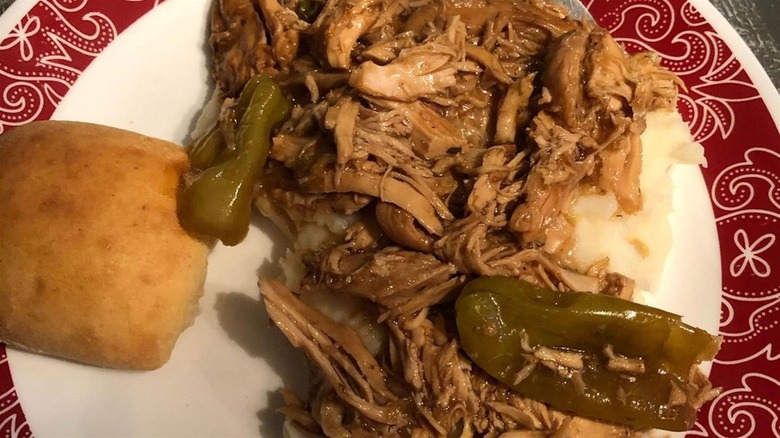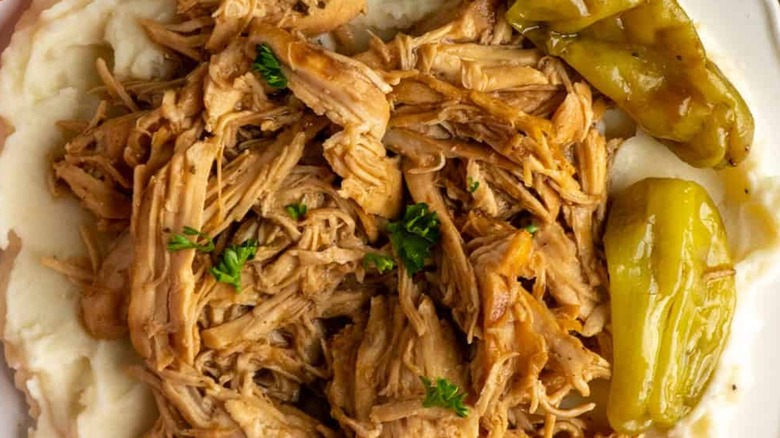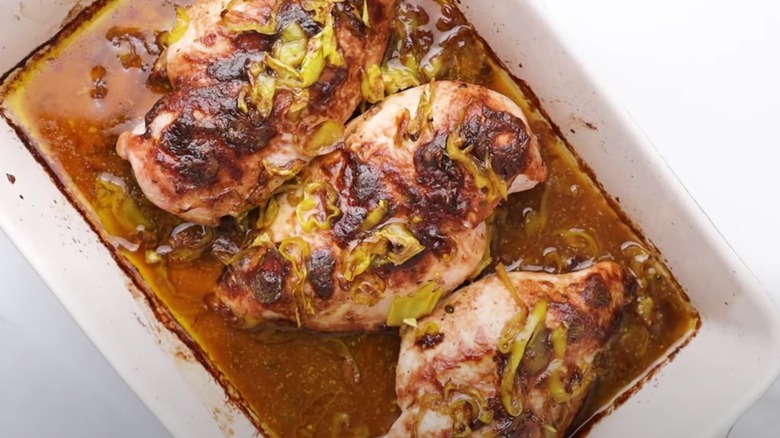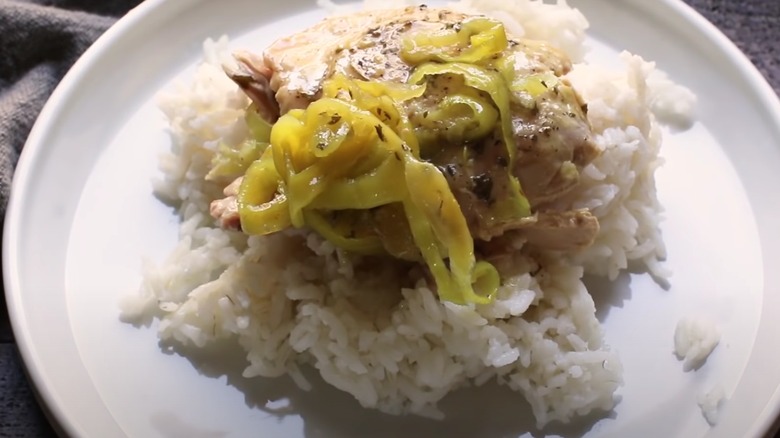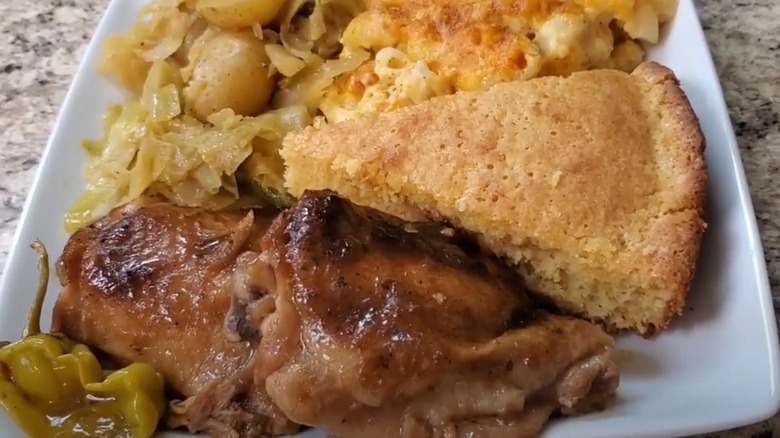Mississippi Chicken Is A Regional Dish Flooded With Flavor
The state of Mississippi may be best known for its namesake mud pie and mud cake, but its cuisine has so much more to offer, ranging from soul food such as fried catfish and collard greens to more unique items like tamales cooked in broth and pickles brined in Kool-Aid. Yet another of the Magnolia State's greatest hits is something you won't find in any restaurant since Mississippi chicken is, instead, a dish that seems to be a favorite of home cooks.
One of Mississippi chicken's main selling points may be the fact that it calls for relatively few ingredients: just chicken, butter, pickled peppers from a jar, and a couple of packets of seasoning mix that are meant to add some mild flavor. The dish is frequently made in a slow cooker and involves zero prep work since all you'll need to do is to open a few packages, throw everything in the crock pot, and set the dial (or digital interface, if you have a more modern appliance) for a few hours of cooking time. If you're not into slow cooker recipes, though, it's also possible to bake the dish in the oven using the same five ingredients.
How Mississippi chicken evolved
Mississippi chicken seems to be what might be termed a "folk recipe" in that it does not appear to have any one specific point of origin and is spread largely through social media posts and amateur recipe blogs. Some sources, however, note that it may be a variant version of Mississippi pot roast and this is a dish that does have a backstory.
Mississippi pot roast, which dates back to the late '90s or early '00s, is the invention of a woman who wanted to adapt her aunt's somewhat spicy dish into something much milder that would appeal to her children. The aunt's version, it seems, involved packaged Italian dressing mix, but the niece opted to use the more kid-friendly ranch mix instead. This Mississippi pot roast recipe was at first shared only with friends, but in time was published in a church cookbook and thence spread across the newly-fledged internet. So popular was it that, as of 2016, it had been pinned over a million times. Apparently at some point someone, or perhaps numerous someones, had the idea of swapping out the beef for chicken since recipes, like folktales, may tend to evolve over time.
How it's made
Mississippi chicken is often (although not exclusively) made with boneless, skinless, chicken pieces. Some cooks favor using thighs, some use breasts, but either will do. The rest of the ingredients include butter, sliced or whole pepperoncini or banana peppers, and two types of seasoning mix: ranch dressing and au jus. Descriptions of the dish which simply speak of it being made with au jus may be confusing, as this term usually refers to the drippings from cooked meat and isn't likely to be something you'd have on hand unless you'd just made roast beef the night before. Most recipes, however, clarify that this refers to a packet of au jus-style gravy mix, a product that is commercially available.
Once you've assembled all of the ingredients, simply put them in a slow cooker and set it to cook for 4 hours on high or on low for 6 to 8 hours. You could also bake the dish in the oven at 425 degrees Fahrenheit for half an hour or so until a meat thermometer reads 165 F. If you opt to go the baking route, though, you will need a tiny bit of prep as you'll have to put the chicken pieces in a baking pan, sprinkle them with the seasoning mixes, then chop the butter into bits and scatter the pieces over the top along with the pepperoncini.
How Mississippi chicken tastes
Since Mississippi chicken is made with the same ingredients as Mississippi pot roast, apart from swapping the chicken for beef, then it stands to reason that it, too, would be a fairly mild dish. In fact, neither pepperoncini nor banana peppers pack much of a punch. (You can always swap this ingredient out for pickled jalapeños if you want a bit more heat, though.) The ranch dressing mix, too, can add a bit of tang due to the dehydrated buttermilk it often contains.
One TikToker who made the Mississippi chicken recipe (albeit with a few additions including onions, potatoes, and cornstarch) described the results as being "juicy and full of flavor" as well as "delicious." A reviewer on the Country Cook blog, however, noted that they found the au jus mix to be too salty so they preferred to skip it, although it's unclear whether they had tried the recipe with this ingredient and didn't care for it or simply avoided it on general principle. Another person, commenting on that same blog, compared Mississippi chicken to a poultry version of Italian beef, although they admitted that their Chicago-bred tastebuds required the use of an entire jar of pepperoncini along with its liquid in order for the dish to reach its maximum flavor potential.
How to make Mississippi chicken into a meal
There are two schools of thought as to what to do with Mississippi chicken once it finishes cooking. There are some who feel the chicken breasts or thighs should remain intact, but others prefer to shred them. If shredded, the chicken could be used as a sandwich filling — try it with melted cheese on top, or perhaps add some giardiniera to play up on its aforementioned resemblance to the classic Chicago food known as Italian beef. You could also wrap it in a corn or flour tortilla for a unique taco, enchilada, or burrito, or use it to top a baked potato.
If you prefer to keep the pieces intact, Mississippi chicken itself makes for a pretty light entrée, which means it can stand up to a hearty, starchy side such as mashed potatoes. Rice or noodles can also work to round out the meal, or you could go all-in on the Mississippi connection with a Southern-style side like biscuits, cornbread, hush puppies, or macaroni and cheese. To save time, you can even cook up some vegetables along with the chicken to make for a one-pot meal, like the TikToker who added onions and potatoes. Carrots, too, could also work, as could any other root vegetables such as parsnips, turnips, or rutabagas, which all should be sturdy enough to stand up to low, slow cooking.
